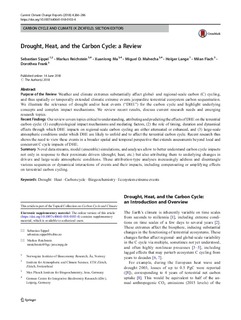| dc.contributor.author | Sippel, Sebastian | |
| dc.contributor.author | Reichstein, Markus | |
| dc.contributor.author | Ma, Xuanlong | |
| dc.contributor.author | Mahecha, Miguel D. | |
| dc.contributor.author | Lange, Holger | |
| dc.contributor.author | Flach, Milan | |
| dc.contributor.author | Frank, Dorothea | |
| dc.date.accessioned | 2018-09-21T10:33:58Z | |
| dc.date.available | 2018-09-21T10:33:58Z | |
| dc.date.created | 2018-07-02T14:08:37Z | |
| dc.date.issued | 2018-06-14 | |
| dc.identifier.citation | Current Climate Change Reports. 2018, . | nb_NO |
| dc.identifier.issn | 2198-6061 | |
| dc.identifier.uri | http://hdl.handle.net/11250/2563884 | |
| dc.description.abstract | Purpose of the Review Weather and climate extremes substantially affect global- and regional-scale carbon (C) cycling, and thus spatially or temporally extended climatic extreme events jeopardize terrestrial ecosystem carbon sequestration. We illustrate the relevance of drought and/or heat events (“DHE”) for the carbon cycle and highlight underlying concepts and complex impact mechanisms. We review recent results, discuss current research needs and emerging research topics. Recent Findings Our review covers topics critical to understanding, attributing and predicting the effects of DHE on the terrestrial carbon cycle: (1) ecophysiological impact mechanisms and mediating factors, (2) the role of timing, duration and dynamical effects through which DHE impacts on regional-scale carbon cycling are either attenuated or enhanced, and (3) large-scale atmospheric conditions under which DHE are likely to unfold and to affect the terrestrial carbon cycle. Recent research thus shows the need to view these events in a broader spatial and temporal perspective that extends assessments beyond local and concurrent C cycle impacts of DHE. Summary Novel data streams, model (ensemble) simulations, and analyses allow to better understand carbon cycle impacts not only in response to their proximate drivers (drought, heat, etc.) but also attributing them to underlying changes in drivers and large-scale atmospheric conditions. These attribution-type analyses increasingly address and disentangle various sequences or dynamical interactions of events and their impacts, including compensating or amplifying effects on terrestrial carbon cycling. | nb_NO |
| dc.language.iso | eng | nb_NO |
| dc.relation.uri | https://link.springer.com/article/10.1007/s40641-018-0103-4 | |
| dc.rights | Navngivelse 4.0 Internasjonal | * |
| dc.rights.uri | http://creativecommons.org/licenses/by/4.0/deed.no | * |
| dc.subject | Drought | nb_NO |
| dc.subject | Carbon cycle | nb_NO |
| dc.subject | Biogeochemistry | nb_NO |
| dc.subject | Ecosystem extreme events | nb_NO |
| dc.title | Drought, Heat, and the Carbon Cycle: a Review | nb_NO |
| dc.type | Journal article | nb_NO |
| dc.type | Peer reviewed | nb_NO |
| dc.description.version | publishedVersion | nb_NO |
| dc.rights.holder | C The Author(s) 2018 | nb_NO |
| dc.source.pagenumber | 21 | nb_NO |
| dc.source.volume | 4 | nb_NO |
| dc.source.journal | Current Climate Change Reports | nb_NO |
| dc.source.issue | 3 | nb_NO |
| dc.identifier.doi | 10.1007/s40641-018-0103-4 | |
| dc.identifier.cristin | 1595225 | |
| cristin.ispublished | true | |
| cristin.fulltext | original | |
| cristin.qualitycode | 1 | |

